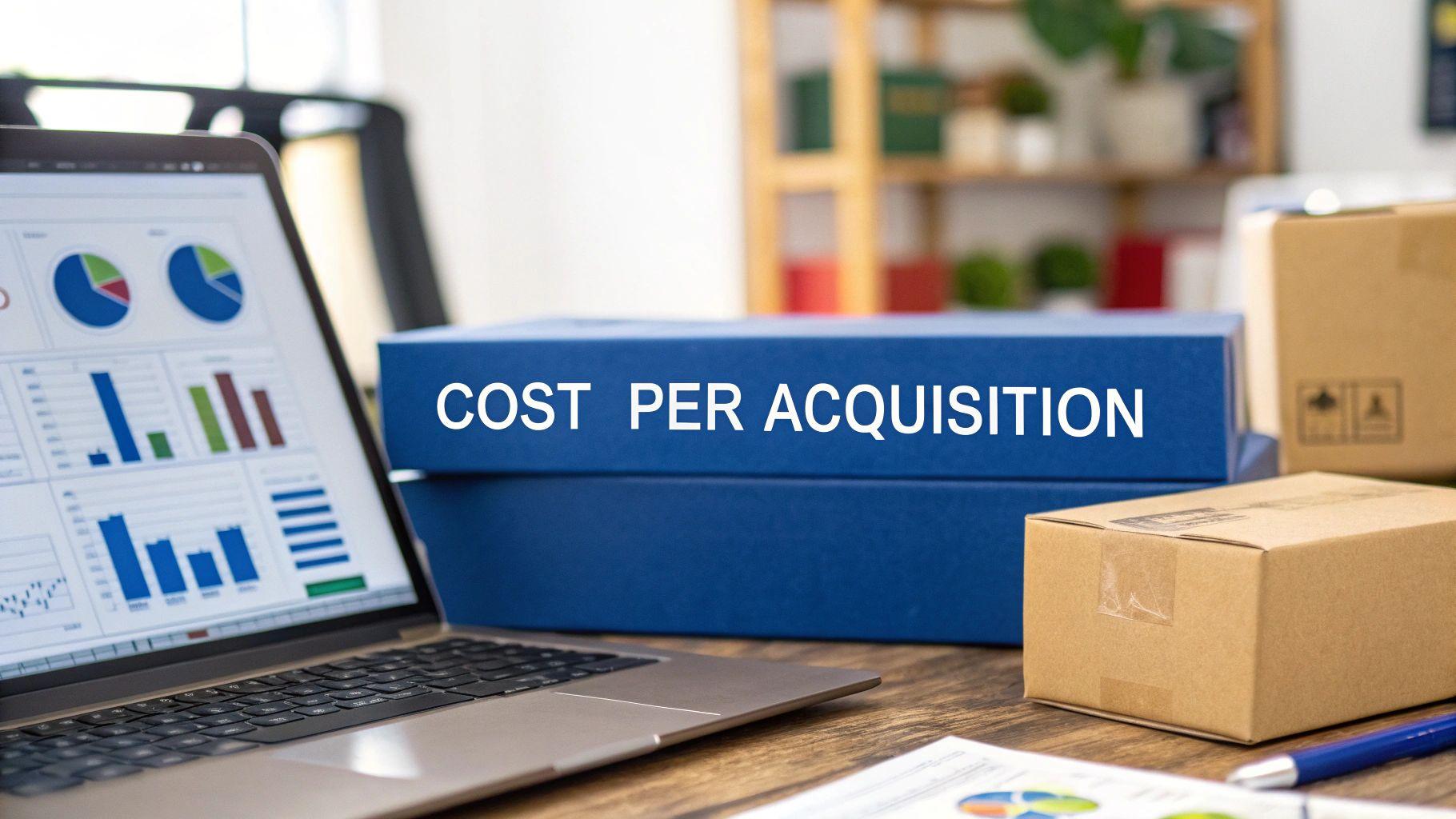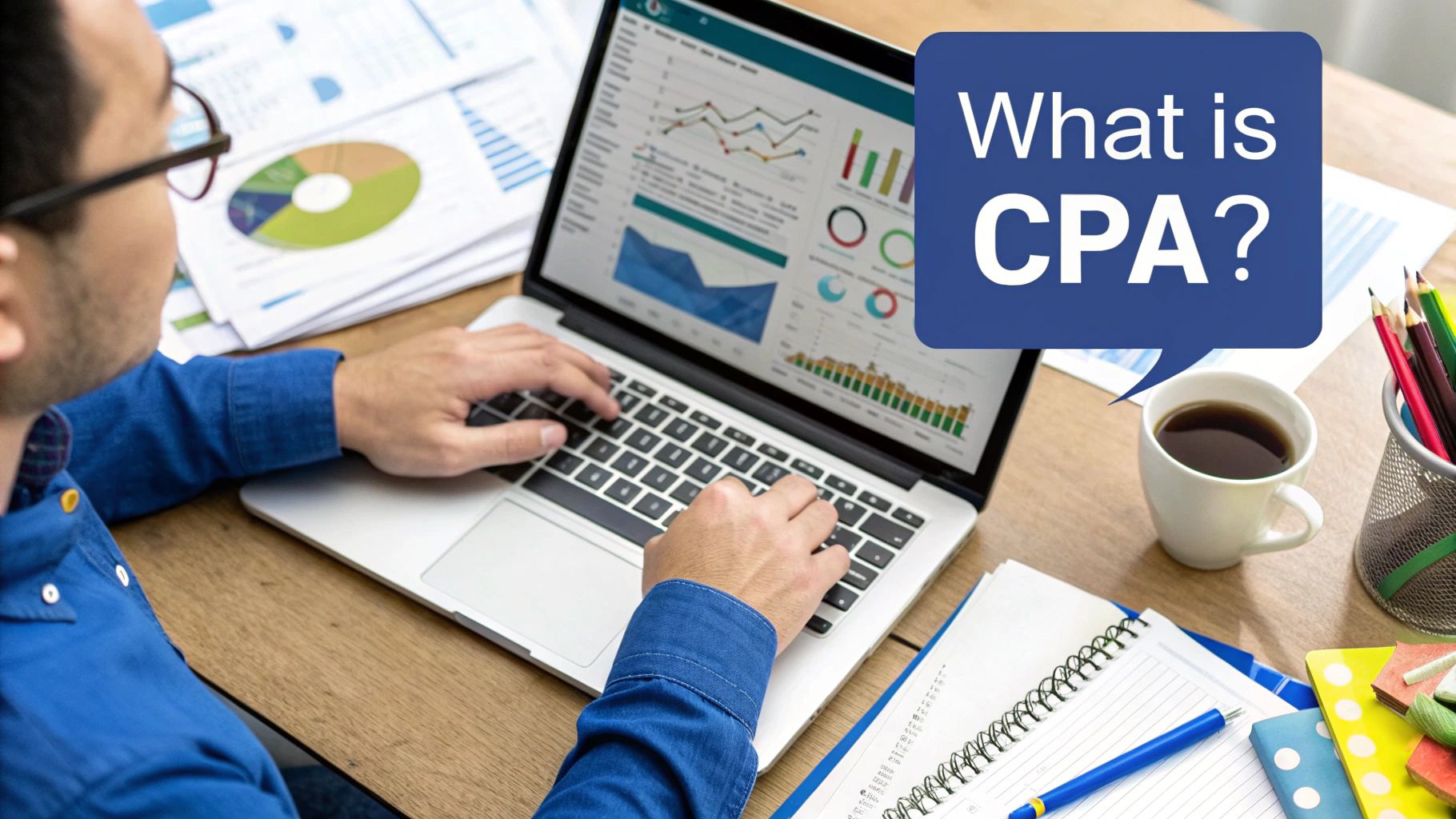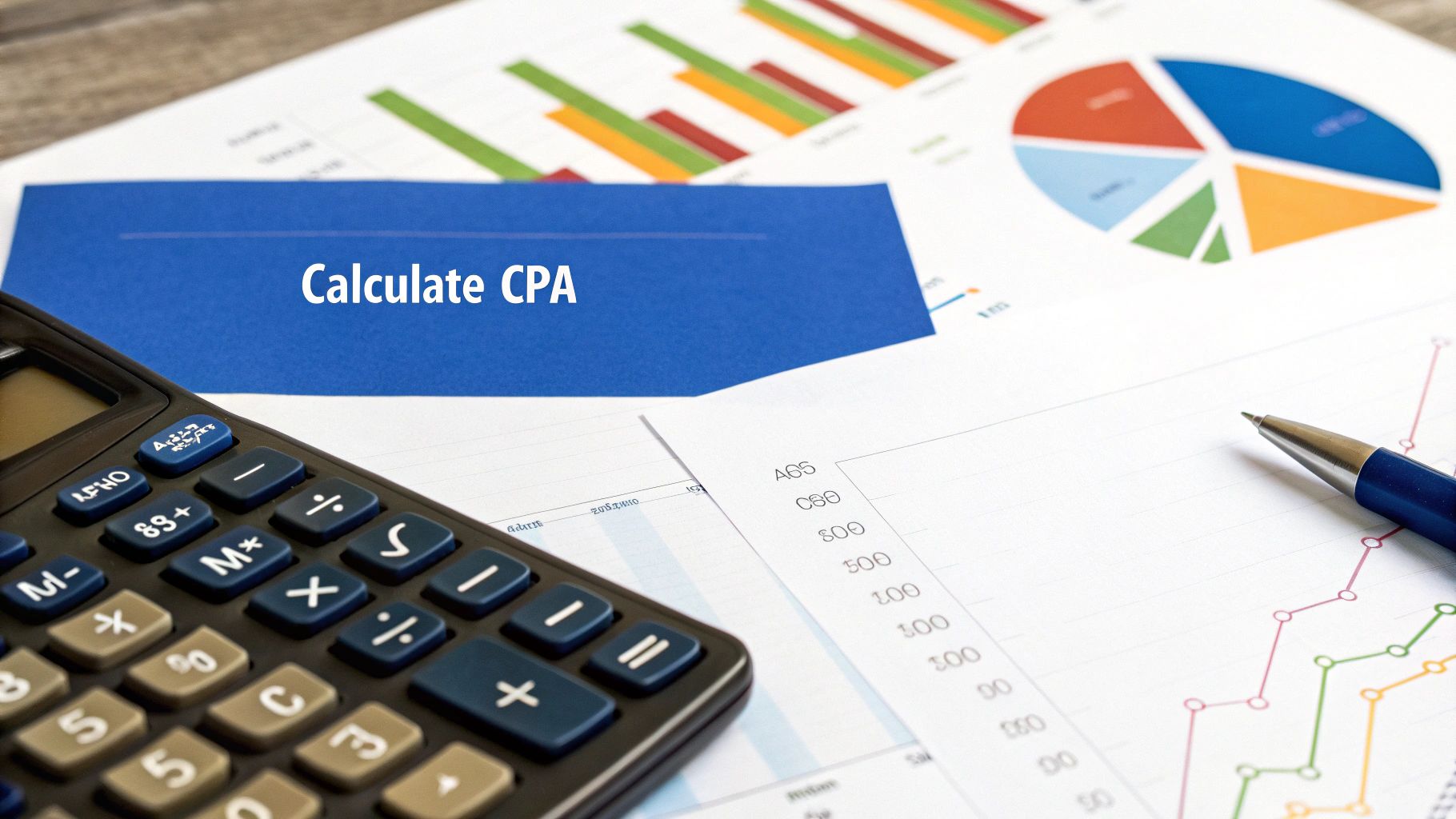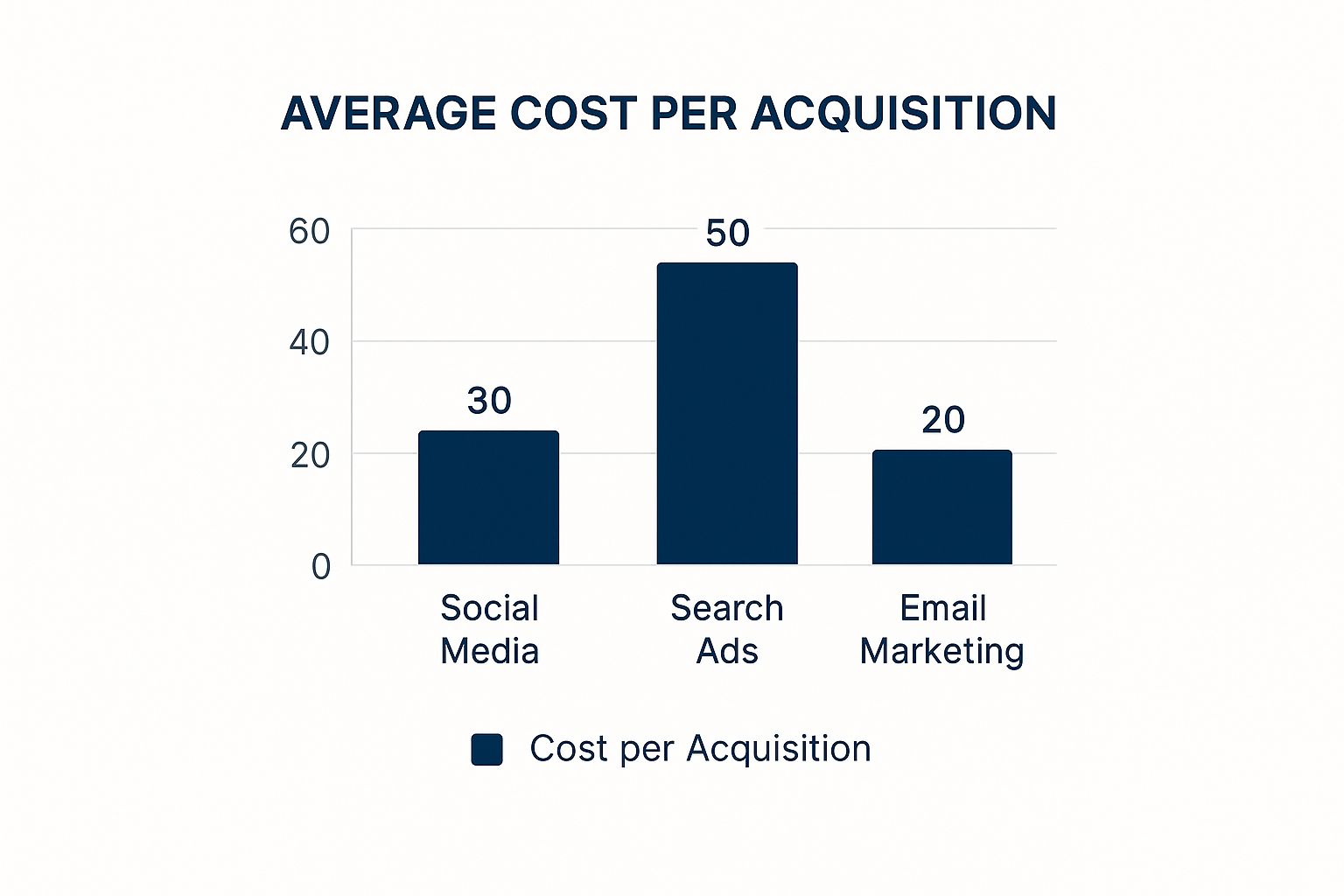What Is Cost Per Acquisition on Amazon? A Performance-First Guide
Understand what is cost per acquisition (CPA) for Amazon. Learn how to calculate, benchmark, and lower your CPA to drive profitable growth for your brand.

Cost Per Acquisition, or CPA, is the total advertising cost required to acquire one new customer. It's the ultimate report card for your ad spend efficiency, cutting straight to the core question: are my ads actually driving profitable growth?
For eCommerce leaders, CPA isn't just another PPC metric; it's a strategic number that connects ad spend directly to your P&L. It forces a shift from "how much are we spending?" to the far more critical question, "what is the bottom-line cost to win a customer?"
What Is Cost Per Acquisition Really

Think of CPA as the final receipt for a sale that came directly from your ads. While metrics like clicks (CPC) and impressions (CPM) are useful inputs, they only tell part of the story. They measure activity, but CPA measures the outcome. It's the bottom-line cost of turning a curious shopper into a paying customer.
For any Amazon brand serious about sustainable scale, mastering CPA is non-negotiable.
Cost Per Acquisition is your North Star for profitability. It cuts through vanity metrics, providing a crystal-clear measure of your advertising's financial performance and its impact on your unit economics.
This performance-first mindset isn't new. CPA became a cornerstone of digital marketing as brands demanded accountability beyond impressions. It has since evolved into the definitive metric for calculating the true cost of customer acquisition.
The Simple CPA Formula
At its core, the formula for CPA is beautifully simple.
Total Cost of a Campaign / Total Number of Acquisitions = Cost Per Acquisition
Let’s apply this with a real-world Amazon PPC example. A home goods brand is running a Sponsored Products campaign for a new line of coffee makers.
- They invest $2,000 into the campaign over one month (Total Ad Spend).
- That campaign directly generates 100 sales of the coffee maker (Total Acquisitions).
Plugging those numbers into the formula:
$2,000 (Total Cost) / 100 (Acquisitions) = $20 CPA
This means, on average, the brand paid $20 in advertising to generate each sale. This single number is incredibly powerful. Now, the brand leader can compare that $20 CPA directly against the product’s profit margin to determine if the campaign is truly profitable.
While our focus is Amazon, this logic is universal. This Google Ads Cost Per Action tutorial shows how the same principles apply on other major platforms.
Here’s a quick breakdown of the inputs needed to calculate your own CPA.
Cpa Formula Components Explained
| Component | Definition for Amazon Sellers | Example |
|---|---|---|
| Total Cost | The total amount spent on a specific ad campaign over a defined period. | You spent $2,000 on a Sponsored Products campaign in May. |
| Acquisitions | The total number of orders (sales) directly attributed to that campaign. | The campaign generated 100 orders for your product in May. |
With these two data points, you have everything needed to calculate your baseline CPA and begin making smarter, data-backed decisions with your ad budget.
Why CPA Matters More Than Other Metrics
It's easy to get distracted by metrics like click-through rate (CTR) or a low cost-per-click (CPC). A low CPC might look great on a report, but if those cheap clicks never convert into sales, you're just burning cash.
CPA forces you to adopt a performance-first mindset.
Here’s why it's the metric that growth-focused leaders should obsess over:
- It’s a Direct Link to Profitability: CPA ties ad spend to the actions that generate revenue.
- It’s Your Efficiency Benchmark: It provides a clear number to track, allowing you to measure and improve campaign efficiency over time.
- It Drives Smarter Budgeting: A clear CPA helps you decide where to allocate budget. You can double down on what works and cut what doesn’t, all based on real financial outcomes.
Ultimately, monitoring your CPA isn't just about managing an advertising metric—it's a fundamental strategy for driving profitable growth on Amazon.
How to Calculate Your True Amazon CPA

Calculating Cost Per Acquisition on Amazon seems straightforward. But if you’re only looking at a single campaign’s CPA, you’re missing the bigger picture. To make strategic decisions that grow your entire business, you must move beyond surface-level numbers.
We'll start with the basic campaign-level CPA and then zoom out to a far more powerful, business-level metric that reveals your true cost of customer acquisition—the one that really matters for sustainable scale.
Start with Campaign-Level CPA
First, you must know the CPA for each individual campaign. This is your tactical, ground-level view—it helps identify which ads are performing and which are draining your budget. All the data you need is within your Amazon Advertising Console.
Here’s the simple, two-step process:
- Pull Your Data: Navigate to your advertising dashboard, select a campaign, and set your desired date range (e.g., last 30 days). Note the total Spend and total Orders.
- Calculate: Plug those numbers into the formula: Total Spend / Total Orders = Campaign CPA.
Let's use an example. A Sponsored Brands campaign for a new kitchen gadget spent $1,500 last month and generated 75 orders.
$1,500 (Spend) / 75 (Orders) = $20 CPA
That $20 CPA is a crucial starting point. But it exists in a vacuum. It doesn’t account for how that paid traffic influenced organic sales or how advertising impacts the business as a whole. While our focus is on Amazon, understanding the universal principles of how to calculate customer acquisition cost is valuable for any business leader.
Calculate Your Blended CPA for a Holistic View
To truly understand your advertising's impact, you must calculate your blended CPA. This metric, often viewed through the lens of Total Advertising Cost of Sales (TACoS), reveals how your ad spend affects your total sales—both paid and organic. This is the number that should be on every eCommerce leader's dashboard.
A healthy blended CPA indicates your ads are creating a "flywheel effect." Paid sales boost your product's visibility, which in turn drives more organic sales over time.
The Headline POV: A low campaign CPA is good, but a decreasing blended CPA is the true indicator of sustainable, profitable growth. It's proof that your ad spend isn't just buying sales; it's building brand momentum and fueling organic discovery.
Let's calculate this for our kitchen gadget brand.
Step-by-Step Blended CPA Calculation
Imagine these are your numbers for the last 30 days, pulled from both Seller Central and the Advertising Console:
- Total Ad Spend: $5,000 (across all campaigns)
- Total Orders (Paid + Organic): 1,000 orders
Now, let’s find the blended CPA:
- Total Ad Spend / Total Orders = Blended CPA
- $5,000 / 1,000 = $5 Blended CPA
This $5 blended CPA paints a much clearer, more strategic picture. It tells you that when factoring in all sales, your effective cost to acquire any customer—whether they clicked an ad or found you organically—was just $5. This is a far more powerful metric for judging the overall health and scalability of your Amazon business.
It's also a metric that works best when tracked alongside others, like ROAS. You can dive deeper into that in our guide on how to calculate Return on Ad Spend.
What Is a Good CPA for Your Amazon Business?

Here’s the blunt truth: there is no such thing as a universally "good" Cost Per Acquisition. Chasing a generic industry benchmark is a surefire way to either leave money on the table or run your business into the ground.
A $50 CPA could be a fantastic deal for one brand and a catastrophe for another. The only CPA that matters is the one that works for your product's unique unit economics. Your target CPA isn't a magic number found in a report; it's a strategic figure you calculate based on your profit margins, business goals, and customer lifetime value.
Profit Margin: The Foundation of Your Target CPA
Before setting a target CPA, you must know your numbers inside and out. The most critical factor is your profit margin per unit—before advertising spend. This number defines your break-even point and the absolute maximum you can afford to spend to acquire a customer on their first purchase.
Let's compare two brands to illustrate this.
- Brand A: Premium Skincare. Sells a face serum for $80. After manufacturing, Amazon fees, and shipping, they have a $40 profit per unit.
- Brand B: Everyday Kitchen Sponges. Sells a multi-pack for $15. After all costs, their profit per unit is only $5.
For Brand A, a $30 CPA is perfectly healthy, leaving a $10 profit on every ad-driven sale. For Brand B, that same $30 CPA would be a disaster, losing them $25 on every acquisition. This makes it clear why a one-size-fits-all approach is doomed.
When a High CPA Is Actually a Smart Investment
A high CPA isn't always a red flag. For certain products and strategies, it can be a calculated investment in long-term growth. This is where Customer Lifetime Value (LTV) becomes a critical part of the conversation.
LTV is the total profit you expect to make from a single customer over their entire relationship with your brand.
Consider an Amazon case study: a brand selling premium coffee pods.
- Product Price: $20 per box
- Profit Margin (before ads): $8 per box
- Initial CPA: $12
At first glance, this looks like a failing campaign—they're losing $4 on every new customer. But this brand understands its data. They know the average customer who buys once will return to purchase five more times over the next year through "Subscribe & Save" or direct brand searches.
The Headline POV: We treat PPC as a lever for sustainable growth, not just short-term sales. A high initial CPA is not only acceptable but strategic if it acquires a customer with significant LTV. This fuels long-term profitability and simultaneously boosts organic rankings, creating a powerful growth loop.
This perspective completely changes the math. The real value of that customer isn't the initial $8 profit; it's $48 ($8 profit x 6 total purchases). Suddenly, paying $12 to acquire a $48 revenue stream isn't just acceptable—it's an incredibly profitable investment. For brands with high repeat purchase rates, a willingness to stomach a higher initial CPA is a powerful competitive advantage.
Defining Your Strategic Target CPA
Your target CPA must be a dynamic number that aligns with your current business objective. Are you launching a new product and need to aggressively capture market share? Or are you trying to maximize profit on a mature bestseller?
Here’s a simple framework for setting your goal:
- Break-Even CPA: Equal to your pre-ad profit margin per unit. Hitting this number means you're acquiring customers without losing money on the first sale.
- Profitability-Focused CPA: Set comfortably below your break-even point. If your margin is $20, a target CPA of $12 guarantees a healthy profit on every conversion. This is a common goal for mature, established products. Our guide on how to increase sales on Amazon offers more strategies to support this.
- Growth-Focused CPA: Can be set at or even slightly above your break-even point. This aggressive strategy is used to maximize sales velocity, improve organic rank, and acquire customers with high LTV. Here, you prioritize long-term market dominance over immediate profit.
Ultimately, a "good" CPA is simply one that profitably supports your specific business goals. Stop comparing your numbers to others and start defining a target that makes sense for your bottom line.
Actionable Strategies to Lower Your Amazon CPA
Knowing your target Cost Per Acquisition is the first step. Hitting that number consistently requires a different level of strategic execution.
Lowering your Amazon CPA isn’t about frantically slashing budgets or pausing campaigns. It's about making every ad dollar work smarter through methodical, data-driven optimizations that cut waste, boost conversions, and drive profitable sales.
Let's skip the generic advice and focus on the high-impact levers you can pull on Amazon.

As the chart indicates, paid search often has a higher CPA than other channels, reinforcing the need to make every click count.
Sharpen Your Targeting to Eliminate Wasted Spend
The fastest way to lower your CPA is to stop paying for clicks that will never convert. Irrelevant traffic is the single biggest drain on any Amazon ad budget. By getting laser-focused on who sees your ads, you ensure your budget is spent only on shoppers with high purchase intent.
This comes down to mastering keywords. A shocking 75% of search campaigns leak money from poor keyword targeting, often from over-relying on broad match keywords that pull in irrelevant searches.
Key Insight: Every irrelevant click you pay for directly inflates your CPA. Continuous targeting refinement isn't just a "best practice"—it's a direct path to improved profitability.
Here are two powerful ways to tighten your targeting:
- Aggressive Negative Keyword Sculpting: Make a habit of digging into your Search Term Report. Identify queries triggering your ads that are a poor fit. Selling premium leather dog collars and seeing clicks for "cheap nylon collars"? Immediately add "cheap" and "nylon" as negative keywords. This simple action stops the financial bleed.
- Strategic Match Type Refinement: Broad match keywords are for discovery, not performance. Once you identify high-converting search terms, move them into their own campaigns as phrase and exact match keywords. This gives you granular control over bids and ensures you're visible for the terms that actually drive profitable sales.
Optimize Your Product Detail Page for Conversion
Your product detail page has one job: turn clicks into sales. A low conversion rate is a CPA killer. You could have the world's best-targeted ad campaign, but if your listing fails to convert, you're just paying to send traffic into a black hole.
Improving your conversion rate means you generate more sales from the same number of clicks, which directly lowers your CPA.
Let's do the math. You get 100 clicks at $1 each ($100 total spend). If 5 people buy (5% CVR), your CPA is $20. If you optimize your listing and convert 10 of those people (10% CVR), your CPA is slashed to $10—without touching your ad campaign.
Focus your efforts here:
- High-Quality Imagery and Video: Your main image must stop the scroll. Your other assets must answer questions, highlight benefits, and show the product in use.
- Benefit-Driven Bullet Points: Don't list features; explain the benefit. How does it solve a problem or improve the customer's life?
- Engaging A+ Content: Use this space to tell your brand story, overcome objections, and build the trust needed to secure the sale.
Master Your Bids and Budgets
Your bidding strategy is the engine of CPA performance. Bid too high, you overpay. Bid too low, you miss out on traffic. The goal is to find the sweet spot where you win relevant ad placements at a cost that supports your profit goals.
Amazon's dynamic bidding strategies can be a powerful tool. "Down only" is a safe starting point. For maximum control, however, a structured approach that allows for precise bid adjustments is superior.
Implement a Tiered Bidding Structure:
- Discovery Campaign: Use a broad match campaign with low bids to uncover new, high-intent customer search terms.
- Performance Campaign: When a search term converts well in your discovery campaign, move it to a separate exact match campaign where you can bid more aggressively because you know it performs.
- Negative Keywords: When you "graduate" a keyword to your performance campaign, add it as a negative exact match in the discovery campaign to prevent your campaigns from competing against each other.
To help prioritize, here's a breakdown of these optimization tactics.
CPA Optimization Tactics Comparison
| Optimization Tactic | Primary Impact Area | Implementation Effort | Expected CPA Reduction |
|---|---|---|---|
| Negative Keyword Mining | Targeting Efficiency | Medium (Ongoing) | 15-30% |
| Listing Image/Video Upgrade | Conversion Rate | High (One-time) | 10-25% |
| Tiered Bidding Structure | Bidding Control | High (Setup) | 20-40% |
| A+ Content Enhancement | Conversion Rate | Medium (One-time) | 5-15% |
| Match Type Refinement | Targeting Efficiency | Medium (Ongoing) | 10-20% |
Each strategy requires a different level of effort but offers a significant potential reward. A methodical approach ensures you only bet big on keywords you know will drive profitable sales. Pulling these levers effectively takes deep expertise, which is where a dedicated Amazon PPC management team becomes a force multiplier.
Connecting Paid Ads to Your Organic Growth
This is where dominant Amazon brands separate themselves from the pack. It’s a crucial mindset shift: an optimized Cost Per Acquisition isn't just about saving money on today's campaigns; it's a direct investment in your brand’s long-term organic ranking and defensibility.
Too many sellers view PPC as a cost center. This is a massive strategic error. Smart ad spend is the fuel for your entire Amazon flywheel, not just an expense line. Cutting your budget to chase a lower CPA might improve a weekly report, but it can silently destroy your most valuable asset: organic rank.
The Amazon Flywheel Effect Explained
Amazon’s A9 algorithm operates on a self-reinforcing loop. The "flywheel effect" describes how different inputs feed each other, creating unstoppable momentum. For sellers, PPC is the initial push that gets this flywheel spinning.
A sale from an ad is more than a single transaction; it's a powerful signal to Amazon.
Here’s how that push creates momentum:
- Paid Ads Drive Sales: A well-targeted campaign generates a sale for a specific keyword.
- Sales Velocity Increases: Every sale—paid or organic—contributes to your product's sales history ("sales velocity").
- Amazon's Algorithm Takes Notice: Higher velocity signals to Amazon that your product is highly relevant for that keyword.
- Organic Ranking Improves: Amazon rewards this relevance by boosting your organic ranking for that search term.
- Organic Sales Grow: Higher organic placement leads to more clicks and "free" sales.
- The Cycle Repeats: These new organic sales further increase your sales velocity, improving your ranking even more in a positive feedback loop.
This cycle proves your ad spend is pulling double duty: generating immediate sales while building the organic foundation for future growth.
Why Cutting Ad Spend Can Backfire
Consider a common scenario: a brand with healthy sales velocity slashes its ad budget to boost quarterly profit margins.
Initially, profitability metrics improve. But beneath the surface, the flywheel is slowing. Total sales velocity drops. Amazon's algorithm interprets this as declining popularity.
Before long, organic keyword rankings begin to slide. The product falls to page two for terms it once dominated. Organic traffic dries up, and total sales plummet.
The Headline Takeaway: Treating PPC spend as a pure expense is shortsighted. It is the catalyst for the entire Amazon growth engine. A strategic ad budget, aimed at a smart blended CPA, powers the sales velocity required to win and hold top organic rankings.
We see this frequently. Brands chase short-term profit by gutting ad spend, only to find themselves in a deep hole months later, having lost invaluable organic real estate that is incredibly expensive and difficult to reclaim.
PPC as an Investment, Not an Expense
When you start viewing PPC as an investment, your definition of a "good" CPA changes entirely.
You stop asking, "What is the lowest CPA I can possibly get?"
And you start asking, "What level of ad spend is required to maintain the sales velocity needed to dominate my most important keywords?"
This performance-first approach connects your ad strategy directly to your core business goals: sustainable growth and market leadership. You stop seeing a $20 CPA as a cost and start seeing it as an investment that not only delivered a paid sale but also fortified an organic position that will generate countless more.
Frequently Asked Questions About Amazon CPA
We’ve covered how to calculate and optimize your Cost Per Acquisition. Now, let’s tackle the most common questions we hear from eCommerce leaders applying these concepts.
ACoS vs. CPA: Which One Should I Actually Care About?
This is a frequent question with a simple answer. Advertising Cost of Sales (ACoS) measures efficiency—ad spend as a percentage of ad revenue. CPA measures the absolute cost to acquire one customer.
While ACoS is a useful health check for a campaign, CPA is the superior metric for business-level decisions. It connects directly to your per-unit profit margin, answering the critical question: "Are my ads acquiring customers profitably?"
Our Take: Use ACoS for tactical, in-campaign tweaks. But for strategic decisions—budgeting, goal-setting, and P&L analysis—CPA is king. A low ACoS is nice, but a CPA below your profit margin guarantees you're making money.
How Do I Figure Out a CPA Target for a New Product?
For a product launch, the primary goal is not immediate profit but market penetration and data collection. This requires a willingness to accept a higher initial CPA to get the flywheel spinning.
Your break-even CPA is the perfect starting point. This is simply your product's sale price minus all associated costs (COGS, Amazon fees, etc.).
Let's break it down:
- Product Price: $50
- Amazon Fees & COGS: $30
- Break-Even CPA: $20
In this case, targeting a $20 CPA allows you to acquire customers without losing money on the first purchase. It’s an aggressive but necessary strategy to drive the initial sales velocity needed to start ranking organically and gather the performance data required for future optimization.
What’s a Realistic Timeline for Improving My CPA?
Lowering CPA is a process of methodical testing and refinement, not an overnight fix. While quick wins exist, sustainable improvement takes time.
Here’s a typical timeline:
- Weeks 1-2 (Quick Wins): The fastest impact comes from eliminating waste. Aggressively add negative keywords based on search term reports to cut irrelevant spend. This alone can often reduce CPA by 10-15%.
- Weeks 3-6 (Refinement and Testing): This phase involves more surgical adjustments. You'll refine keyword match types, test ad copy, and make initial data-backed bid adjustments.
- Months 2-3+ (Strategic Optimization): With a solid data foundation, you can deploy advanced tactics. This includes conversion rate optimization on your product detail page and building sophisticated, tiered bidding structures. You are no longer just managing campaigns; you are engineering profitability.
Mastering your CPA is a marathon, not a sprint. Each phase builds on the last, leading to smarter spending and the kind of profitable growth that builds an enduring brand on Amazon.
Ready to stop guessing and start growing? Headline Marketing Agency combines deep Amazon expertise with powerful data analytics to build PPC strategies that drive profitability and sustainable scale. Discover how we can lower your CPA and accelerate your growth.
Ready to Transform Your Amazon PPC Performance?
Get a comprehensive audit of your Amazon PPC campaigns and discover untapped growth opportunities.